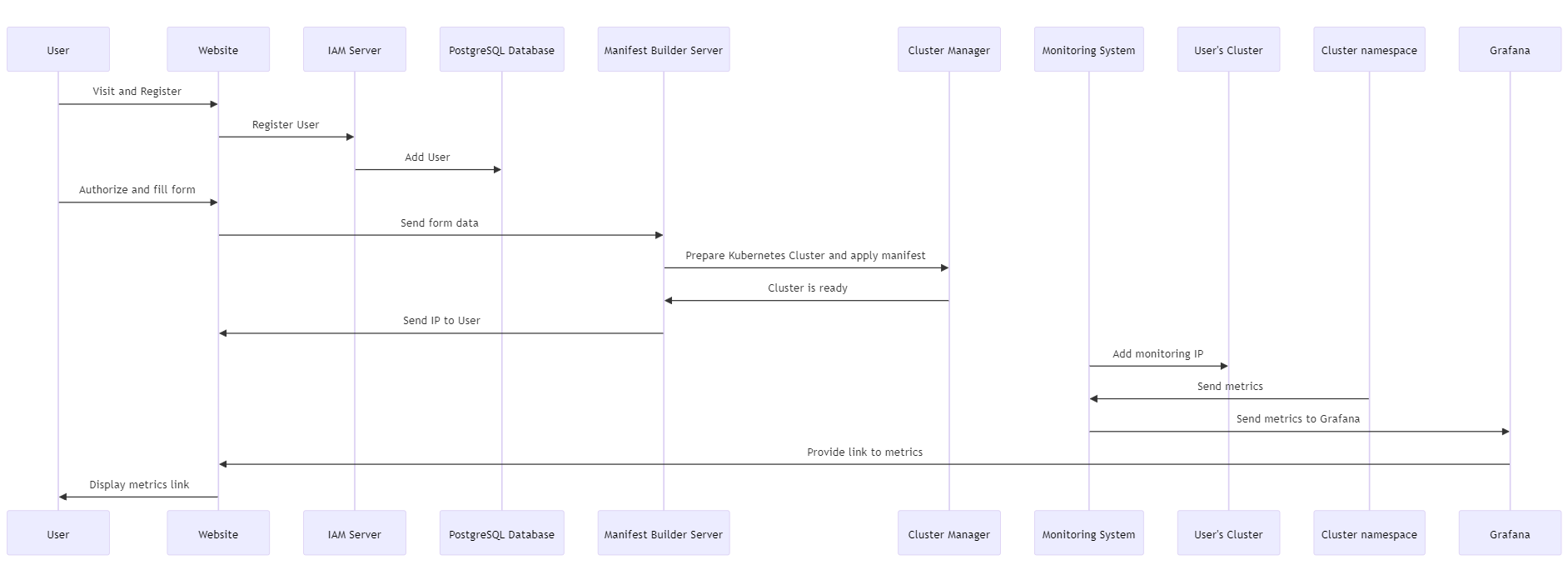Babyhelm #
Presentation #
Week #1 #
Team Members #
| Team Member | Telegram ID | Email Address |
|---|---|---|
| Darya Tolmacheva | @tolmach_d | d.tolmacheva@innopolis.university |
| Iskander Shamsutdinov | @wensiet | i.shamsutdinov@innopolis.university |
| Nikita Bagrov | @nd_guap | n.bagrov@innopolis.university |
| Saveliy Lekhtin | @flakexdd | s.lekhtin@innopolis.university |
| Egor Salnikov | @tellme_who | e.salnikov@innopolis.university |
| Egor Solodovnikov | @netpo4ki | e.solodovnikov@innopolis.university |
| Evgeniy Spiridonov | @forygg | e.spiridonov@innopolis.university |
Value Proposition #
Problem statement: #
Configuring and managing a Kubernetes cluster can be a complex and time-consuming task for developers. It requires a deep understanding of Kubernetes architecture, networking, security, and best practices. This complexity can lead to significant delays in deployment, increased risk of misconfigurations, and a steep learning curve for teams not specialized in DevOps.
Solution Description: #
Our project streamlines the Kubernetes cluster setup and management process. Developers only need to provide a link to their Docker image, and our system automatically handles the rest. We create a dedicated namespace within our Kubernetes cluster where the application will run. Additionally, we offer comprehensive monitoring solutions to ensure the application runs smoothly and efficiently.
Benefits to Users: #
- Ease of Use: Developers can focus on coding rather than managing infrastructure. By simply providing a Docker image link, they bypass the complex setup of Kubernetes.
- Time Efficiency: Rapid deployment reduces time-to-market for applications.
- Enhanced Monitoring: Built-in monitoring tools provide insights into application performance and health, facilitating proactive issue resolution.
Differentiation: #
Our project stands out by offering an all-in-one solution that combines simplicity with powerful functionality:
- Automatic Namespace Provisioning: Unique namespaces are created for each application, ensuring isolation and security.
- Seamless Integration: Supports various Docker images, making it versatile for different application needs.
- Comprehensive Monitoring: Integrated monitoring tools offer real-time insights and alerts, which is often an add-on in other solutions.
- Developer-Centric Approach: Tailored to meet the needs of developers, reducing the barrier to adopting Kubernetes.
User Impact: #
Our solution significantly enhances productivity and reduces the operational burden on developers. By automating the Kubernetes setup, developers can deploy applications quickly and with confidence, knowing that they are running in a well-configured and monitored environment. This leads to faster iteration cycles, improved application reliability, and better resource utilization.
User Testimonials or Use Cases: #
Rapid Deployment: Our project leverages Kubernetes’ main feature of high availability and facilitates quick deployment without requiring a deep understanding of Kubernetes. By simply providing a Docker image link, developers can have their applications running within minutes, significantly reducing deployment time.
Enhanced Monitoring: Development teams benefit from the integrated monitoring tools, which offer real-time insights into application performance. This proactive approach helps identify and resolve issues before they escalate, ensuring smoother operations and higher uptime.
DevOps Simplification: Companies can streamline their DevOps processes by leveraging our solution. Developers are empowered to deploy applications independently, while DevOps engineers can focus on optimizing infrastructure rather than managing day-to-day Kubernetes configurations.
Lean Questionnaire #
Please answer the following questions related to the lean methodology:
What problem or need does your software project address?
Our software project addresses the complexity and time-consuming nature of configuring and managing Kubernetes clusters. This task often requires specialized DevOps skills and can lead to deployment delays and misconfigurations for development teams.
Who are your target users or customers?
Our target users are developers and development teams who need to deploy applications on Kubernetes clusters but lack the time, expertise, or resources to manage the intricate setup and ongoing maintenance. This includes small to medium-sized businesses, startups, and individual developers focused on rapid application deployment.
How will you validate and test your assumptions about the project?
- Internal Testing: We will rigorously test the software ourselves to ensure it meets our standards for functionality and performance.
- User Testing: We will invite users to test the platform and provide detailed feedback on their experience.
What metrics will you use to measure the success of your project?
- Deployment Time Reduction: The time saved in deploying applications compared to traditional Kubernetes setups
- Customer Satisfaction: Feedback scores from user surveys and Net Promoter Scores (NPS).
- System Uptime: The reliability and availability of the deployed applications.
How do you plan to iterate and pivot if necessary based on user feedback?
- Feedback Loops: Maintaining open communication channels with users for continuous feedback.
- Regular Updates: Implementing user-requested features and improvements in regular software updates.
Leveraging AI, Open-Source, and Experts #
AI Integration:
- Utilize AI tools like ChatGPT to ask questions and gain insights during the development process.
Open-Source Technologies:
- Kubernetes: For container orchestration.
- Splunk: For monitoring.
- Helm: For package management.
- Poetry: For dependency management.
- GitLab CI/CD: For continuous integration and delivery
Defining the Vision for Your Project #
- Overview:
Our vision is to simplify the deployment and management of applications on Kubernetes clusters. By leveraging open-source tools, we aim to create a platform where developers can easily deploy their Docker images with minimal configuration and benefit from integrated monitoring and management solutions.
- Schematic Drawings:

User visits the website to register, providing their information, which is stored in a PostgreSQL database via the IAM server. Upon authorization, user fills out a form, triggering the creation of a Kubernetes cluster by the Manifest Builder Server, whose IP is then communicated back to the user via the website. Simultaneously, the monitoring system tracks server activities, including the user’s cluster, forwarding metrics to Grafana for visualization. Finally, the website displays a link to these metrics for the user’s access.
- Tech Stack: Python, React, FastAPI, kubernetes, Grafana, PostgreSQL.